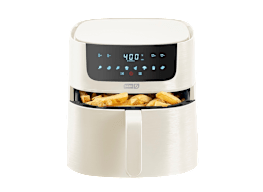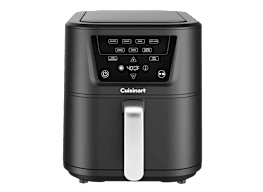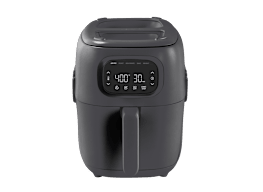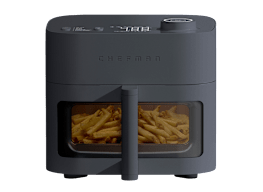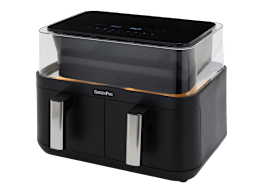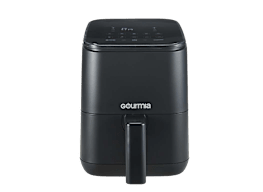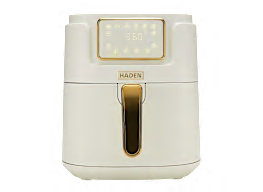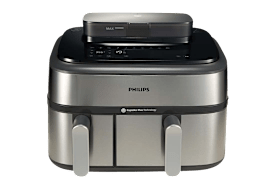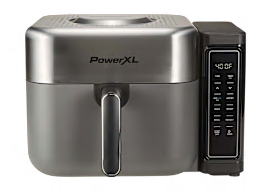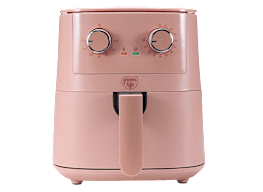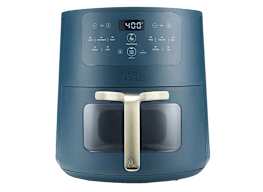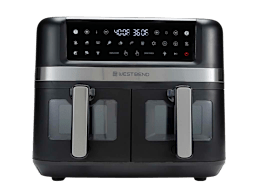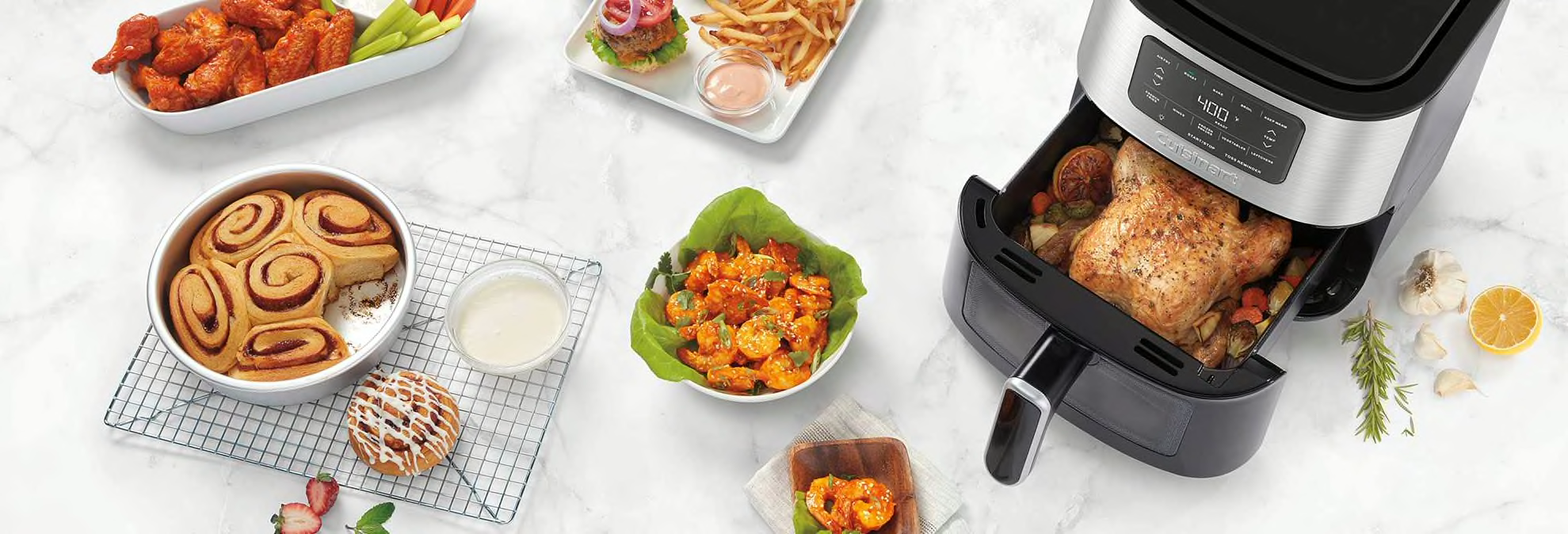
How to Pick the Perfect Air Fryer

Home & Kitchen Writer
Frying food in oil the old-fashioned way yields great results, but it’s time-consuming and messy. Ovens do a decent job of crisping up some foods, but they can’t replicate the superior crunch you get with frying.
That’s where air fryers come in. Since they were introduced in 2010, they’ve changed the game in the kitchen. You can use them not only to air-fry foods to crispy perfection (with minimal oil) but also to reheat leftovers, cook pizza, toast and melt the perfect grilled cheese sandwich, roast everything from veggies to a whole chicken, dehydrate herbs, and even bake sweet treats.
How Do Air Fryers Work?
Air fryers don’t technically fry food. They’re called air fryers because of their ability to reproduce the crispy, fried-food texture you know and love. Inside, a fan circulates hot air to cook the food and crisp up its exterior. It’s basically convection baking, but the small space of the air fryer and concentration of hot air make it more effective at creating a crispy exterior on whatever you’re cooking.
The appliance’s functionality has evolved. Once considered a handy kitchen gadget for cooking fries, nuggets, and wings, the air fryer has proved capable of much more. In particular, it reheats food in a fraction of the time it would take your oven or cooktop, offering a convenient way to heat up leftovers.
How CR Tests Air Fryers
Consumer Reports buys and tests air fryers from over 40 brands—including Bella, Cosori, Cuisinart, Dash, Gourmia, Instant, Ninja, and Philips—to find out whether they’re worth making room for on your kitchen counter. Each appliance is evaluated and rated based on its controls, how quiet it is while operating, and how easy it is to clean.
Controls: Our engineers judge how intuitive each model is to use, evaluating its buttons, dials, or digital display, and how clear any lettering is. Along with settings for cook temperature and time, many air fryers come with preset buttons that help guide you on cooking time and temperature.
Noise: Our testers place each air fryer on a countertop in the lab. They then use a sound-level meter to take multiple measurements of how loud each air fryer is during operation, noting the noise at its peak. (Check out the quietest air fryers from our tests.)
Cleaning: No matter how well an air fryer cooks or reheats your food, if cleanup is a hassle, we want you to know. That’s why our testers judge how easy it is to clean each model’s interior and exterior. (We also have advice on the best way to clean an air fryer.)
For more details on how we test air fryers, watch the video below.
How to Pick an Air Fryer
Our air-fryer ratings provide information on each model’s controls, noise level, and ease of cleaning. Here are some other factors to consider when shopping for one.
Price: The air fryers in our ratings sell for $30 to $350. But most models are priced at $100 or less, so it’s possible to find a high-performing one at a reasonable price.
Capacity: Air fryers are designed to fit on a counter. Most aren’t big enough to cook for a crowd unless you cook in batches. But there are a handful of roomy air fryers that can accommodate substantial amounts of food, such as multiple cuts of meat, a whole chicken, and even a small baking pan or muffin tin.
Our guide to the best large air fryers focuses on models with a basket size of 5 quarts or larger, while our roundup of the best small air fryers highlights models with a capacity of 5 quarts or less. One important note: In our labs, we measure the actual usable capacity of the air fryers we test, and we often find that the space is smaller than the capacity claimed by the manufacturer.
Advanced features: With many appliances competing for precious countertop space, choosing an air fryer with modes such as dehydration, baking, and rotisserie cooking enables you to combine the functionality of multiple appliances into a single device. Additional presets for specific foods and indicators that notify you when to check on the cooking process can also be helpful. Many models also feature a “keep warm” function to maintain the temperature of your food, keeping it hot and crispy.
Warranty: The shortest warranty of the air fryers we tested is 60 days—not exactly a confidence booster. Others in our air-fryer ratings have a one- or two-year warranty, but you may run across some with coverage up to three years. We note these specifics on the model page of each model we’ve rated.
Should I Buy an Air Fryer or a Toaster Oven With an Air-Fry Setting?
Many toaster ovens now offer an air-fry setting, designed to replicate what air fryers do so well. The question is, which appliance does the job better?
The answer depends largely on the specific toaster oven you’re considering and what you intend to use it for. Part of what makes air fryers particularly successful at crisping foods is the relatively small, concentrated space in which hot air circulates.
Toaster ovens usually have larger interior capacities. And while an air fryer’s basket isn’t thoroughly airtight, it may do better at keeping hot air inside than a toaster oven, where air can escape around the sides of the door (and opening the door to check on your food allows a lot of heat to escape). Generally, air-frying toaster ovens often can’t achieve the same level of crispiness as true air fryers.
To more closely imitate air fryers, the air-fry settings on many of these toaster ovens attempt to direct heat toward a specific zone of the oven, and they often come with special air-frying baskets to facilitate this. CR’s testers have found that these combo devices can deliver good results, though they may not achieve an extra-crunchy texture in the food you cook.
Plus, toaster ovens can accommodate larger batches of food than most air fryers. You may also find it easier to open a toaster oven door and slide a tray inside compared with handling things in a deep air-fryer basket. And though air fryers can cook things more quickly, they may also crisp up the exterior of foods before the interior is fully cooked. Toaster ovens perform similarly to full-sized ovens, which might be more familiar and predictable for many cooks.
It’s worth noting that some air fryer models are now designed more like toaster ovens, featuring doors that open outward and interior racks. That puts them in more direct competition with toaster ovens, but they lose some of the perks of basket-style air fryers.
All that aside, your decision may come down to what makes sense for your budget. The toaster ovens that offer air-fry modes tend to be much pricier than most air fryers.
Types of Air Fryers
There are two primary types of dedicated air fryers on the market today. The conventional design has a drawerlike basket where you place food to cook, while newer iterations come outfitted with a mesh tray or rack. Choosing the right one for you comes down to your particular needs.
One note: CR doesn’t currently test paddle air fryers, which are basket-style auto-stir models. They allow users to “set it and forget it” as the paddle moves food around to ensure even heating.
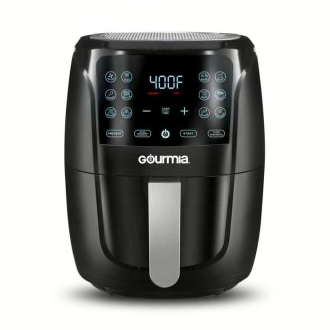
Basket Air Fryers
Air fryers with baskets (or drawers) dominate the market. With these models, the basket where you place your food typically has a handle that locks it in place and activates the cooking element. You can also pull out the basket and use the handle to toss the food partway through cooking to make sure your food gets cooked evenly.
Basket air fryers are available in digital and manual forms. Digital models enable you to control cooking time and temperature with the press of a button. More often than not, these models, equipped with digital touchpads, also feature presets for common foods and indicators to notify you when the basket has reached its intended temperature.
Manual types often cost less, but they don’t offer the advanced features that digital models do. Instead, these units are controlled by analog dials for setting the temperature and cook time. While food is cooking, the dial ticks down, and when it’s ready, you’ll hear a ding and the air fryer will automatically shut off.
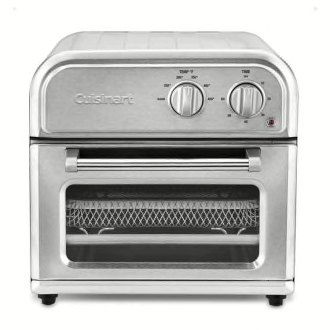
Tray Air Fryers
Air fryers with mesh trays (or racks) are also an option. Unlike air fryers with baskets, these units cook food in a flat or shallow receptacle, much like a toaster oven. Some models have room for just one tray, but several models on the market have multiple racks, and a small number even come with attachments for rotisserie cooking, dehydrating, and grilling.
These models, much like their basket counterparts, offer the option of manual or digital control, with functions that operate in a similar manner. Unlike most basket air fryers, the tray models have clear glass doors that allow you to monitor the food while it’s cooking.
Another advantage of these air fryers is the amount of food you can cook. Those with multiple racks allow you to cook vegetables, meats, and sides simultaneously, and often take up the same amount of counter space as models with a basket.
Air Fryer Brands
Here are some of the brands you’ll see in our air-fryer ratings.
Black+Decker is well-known for its countertop appliances. Its air fryers are sold on Amazon and in stores such as Bed Bath & Beyond, Kohl’s, Target, and Walmart.
Chefman makes a variety of countertop appliances, including blenders, coffee makers, and slow cookers. You’ll find the company’s air fryers sold online and at various retailers, including Bed Bath & Beyond, Costco, Target, and Walmart.
Cosori offers a range of home cooking essentials at fairly inexpensive prices. Air fryers from this brand are available on Amazon and at major retailers, including Bed Bath & Beyond, Home Depot, Target, and Walmart.
You probably know Cuisinart for its food processors, but the company also manufactures a range of countertop appliances, including air fryers and toaster ovens with an air-fry function. You’ll see its air fryers online, including on Amazon, and at Best Buy, Home Depot, Target, Walmart, and Wayfair.
Dash offers several high-performing, less expensive air fryers. They’re sold on Amazon and at major retailers, including Bed Bath & Beyond, Target, and department stores.
The midpriced brand Elite Gourmet offers various sizes of air fryers. They’re sold on Amazon and at major retailers, such as Home Depot and Walmart.
Gourmia, a brand that manufactures a variety of countertop appliances, makes air fryers that are sold on Amazon and at Lowe’s, Target, and Walmart.
Hamilton Beach is a major maker of countertop appliances. You can find them on Amazon and at major retailers, including Bed Bath & Beyond, Target, Walmart, and department stores.
Instant is known for its Instant Pot multi-cookers, which inspired cookbook authors and millions of home cooks. It now makes blenders, toaster ovens, air fryers, and more. Its air fryers are sold on Amazon and at Best Buy, Home Depot, Macy’s, Walmart, and other retailers.
Ninja is a widely recognized brand that manufactures a variety of countertop appliances, including several air fryers featured in CR’s ratings. They’re sold on Amazon and at Bed Bath & Beyond, Target, Walmart, and other major retailers.
Oster offers a range of countertop appliances, including air fryers, at comparatively low prices, and they’re widely available online and at major retailers.
This As Seen On TV brand’s air fryers are available on Amazon and Wayfair, and at major retailers, including Target and Walmart.
















